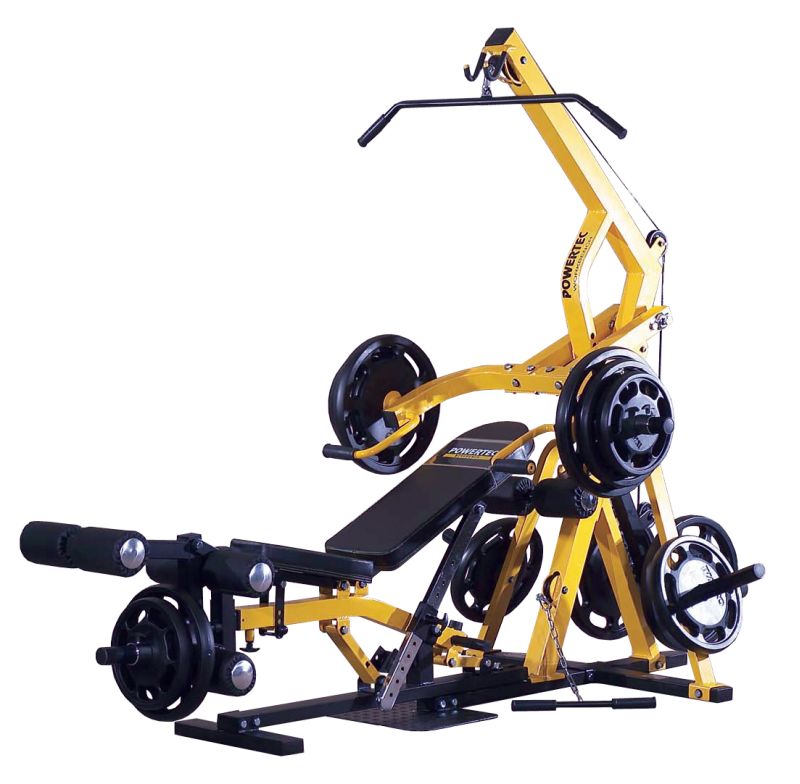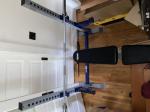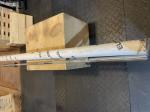Leverage Your Way to Muscle Mass Gains
Reprinted from IRON MAN Magazine, April 2001 By Ken Domzalski
The word leverage has numerous meanings in everyday life, such as "influence," "power" and "authority." In the strength-training industry it's associated primarily with weight-training machines.
Leverage Your Way to Muscle Mass Gains: A Brief History
Although levers have been used in weight training for many years-the T-bar apparatus is essentially a lever arm built into a basic frame structure-it wasn't until the early 1980s that the first full line of leverage machines was developed.
It consisted of approximately 10 machines that simulated mainly compound exercises, such as bench presses, squats and dips. The machines were developed for the gym market and were popularized in places like Gold's Gyms and Bally's health clubs. A number of NFL teams were the first to use them.
The initial results were extremely positive. Over the next few years a number of commercial strength-equipment companies also released lines of leverage machines, and soon hundreds of gyms were incorporating them into their facilities. For almost 20 years such machines have only been available in commercial gyms. Fortunately, they're now becoming readily available for home use.
Before leverage machines were introduced, there were two traditional methods of strength training. The most common was barbells and dumbbells, otherwise known as free weights, and the other was conventional weight-stack machines, which moved via cables, belts, pulleys and cams. Both types of equipment can successfully produce gains in strength and muscular development, but they also have their limitations.
Free-weight exercises, while providing a natural, free-form type of resistance, can also cause an uncontrolled, at times even sloppy, exercise performance through the full range of motion. While you can progress and grow using barbells and dumbbells, the lack of control, balance and stability can be wasteful and even dangerous, especially if you're using heavy weights without assistance.
Another pitfall with free-weight training is the fact that, if you're working out alone, you can't push the muscle to true failure, which can only occur on the last few heavy repetitions of a set. In order for real growth to take place, you need to work to that type of maximum level on each set. If you don't have a spotter, chances are you won't attempt the last one or two key repetitions needed for growth. If you do and you fail, you may become trapped by the barbell, which can be a serious situation, as I'm sure many of you have discovered.
While the conventional machine solves some of those problems, it also has shortcomings. The traditional machines used in the circuit-training area of gyms or in typical multi station home gyms generally incorporate a pin-selected weight stack as the resistance, which is driven by a cable-and-pulley operation. Some machines also use a cam or tension arc device. They all tend to limit you because they follow a predetermined, sometimes restricted range of motion that can vary in terms of function and resistance. In addition, any type of cable or belt-driven machine is going to cause some friction and drag that takes away from the natural feel of pure resistance you experience with free weights, which can limit your gains.
Creating the Perfect Training Tool
The first step in the development of leverage machines was to pick the most effective free-weight exercises. A frame-and-bench structure was engineered to put the user into the correct position, and a lever arm with a fulcrum was built into the frame. The lever arm had a certain length, and the pivot was set at a particular height in order to duplicate the precise arc, or range of motion, that you work through with the barbell.
Weight plates were then loaded near the hand grips to re-create the same natural resistance you experience with a barbell or dumbbell. There are no cables, pulleys, cams or friction. The result is quite simple and basic: The lever arm replaces the barbell while ensuring control and safety. It's the perfect combination of free weight and machine.
Faster Gains With Leverage
Leverage machines have successfully produced accelerated gains in overall muscular size and strength. They can do that because they provide the same natural gravity forces as a barbell or dumbbell. That type of raw, pure resistance is the most effective means of force against the muscle. We know free-weight training works, but, as discussed above, it has limitations.
Leverage machines, because they safely control the exercise at all times, allow you to push the muscle to total failure. That's the reason leverage is the superior form of anaerobic strength training and why thousands of bodybuilders and pro athletes use these machines every day. Until recently, you could only find leverage machines at your gym.
Three factors are involved in gaining strength and size with leverage machines. One is the workout itself, the second is proper nutrition, and the third is rest. All are equally important. Proper nutrition feeds and energizes your body to work and grow. The body needs ample rest between workouts for muscle tissue to recover and rebuild. That leaves the workout. So the question is, How often and how much should you train?
Bodybuilders are bombarded with thousands of routines, most of which only add to the confusion. The fact is, training for strength and size is very simple and always has been. You don't need hours in the gym and multiple sets upon multiple sets to get results. You actually need very little. Quality, not quantity, is the key.
Research has proven that a very brief, 20-to-30-minute workout with maximum effort and at least 48 to 72 hours between sessions will produce substantial gains in muscular strength, which produces growth. It takes only a handful of basic exercise and one set to failure. That is where leverage machines offer an advantage. It's truly difficult for most people to push to failure with other methods. Leverage machines allow you to work to your maximum.
Leverage Machine Workouts
Guidelines
- Perform two to three sessions per week with a minimum of 48 to 72 hours between workouts.
- Choose only one to two exercises per muscle group.
- Perform only one set per exercise and work each set to failure.
- Perform six to 10 repetitions per set. When you reach 10, increase the weight for your next workout, which should take you back to six reps.
- Use the following eight-second rep count: two-second positive, two-second hold in the contracted position, four-second negative.
- Use the following routines, switching from one to the other every so often.
- Choose one of the following warm up exercises to begin each session and do 20 repetitions at a faster pace: squats, chest presses or lat pulldowns.
- Take one week off from training every two months to allow your muscles the full recovery necessary for continued growth and progress.
Total-Body Routine
Take at least three days rest between workouts.
- Leverage squats (thighs, hamstrings, buttocks)
- Leverage leg extensions or leg curls (thighs, hamstrings)
- Leverage calf raises (calves)
- Leverage chest presses or flyes (pectorals)
- Leverage dips (triceps, pectorals)
- Leverage shoulder presses (deltoids)
- Leverage shrugs (traps, deltoids, back)
- Leverage lat pulldowns, rows (back)
- Leverage arm curls (biceps, forearms)
- Leverage crunches (abdominals)
Split-Body Routine
Take two to three days' rest between workouts.
Session 1
- Leverage chest presses
- Leverage flyes
- Leverage dips
- Leverage shoulder presses
Session 2
- Leverage squats
- Leverage leg extensions
- Leverage leg curls
- Leverage crunches
Session 3
- Leverage shrugs
- Leverage lat pulldowns
- Leverage rows
- Leverage arm curls
Leverage machine best prices:
Body Solid SBL460 PowerLift Freeweight Leverage Gym
Recent Articles
-
Bench Press Full Set
Jul 06, 22 01:48 PM
Weights/Bar/bench/clamps/safety bars,etc! Everything is included and is In VERY good condition! About 300lbs of weight along with a adjustable/removable -
Eleiko Olympic training bar
Sep 20, 21 02:39 PM
Bar has been used less than one year. It is in superb shape. Same bar new is almost $1,000 dollars. Selling for 800.00.I Have the tube to ship it. Razor4wolverines@yahoo.co -
Olympic weights
Jul 07, 21 05:35 PM
I have 395 pounds of weight Including the barbell. 4)45 2)35 2)25 2)10 4)5 4)2.5 contact: Guadron193@gmail.com









